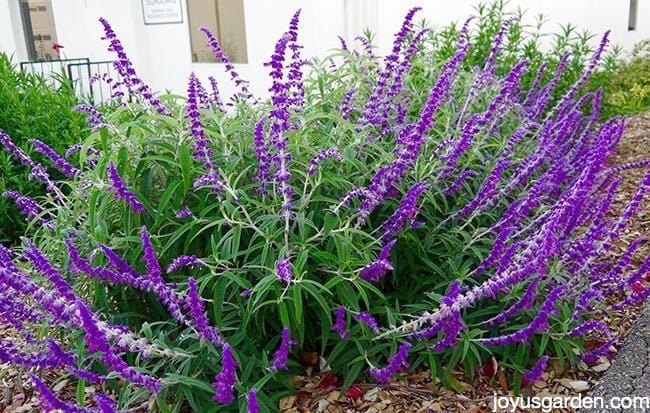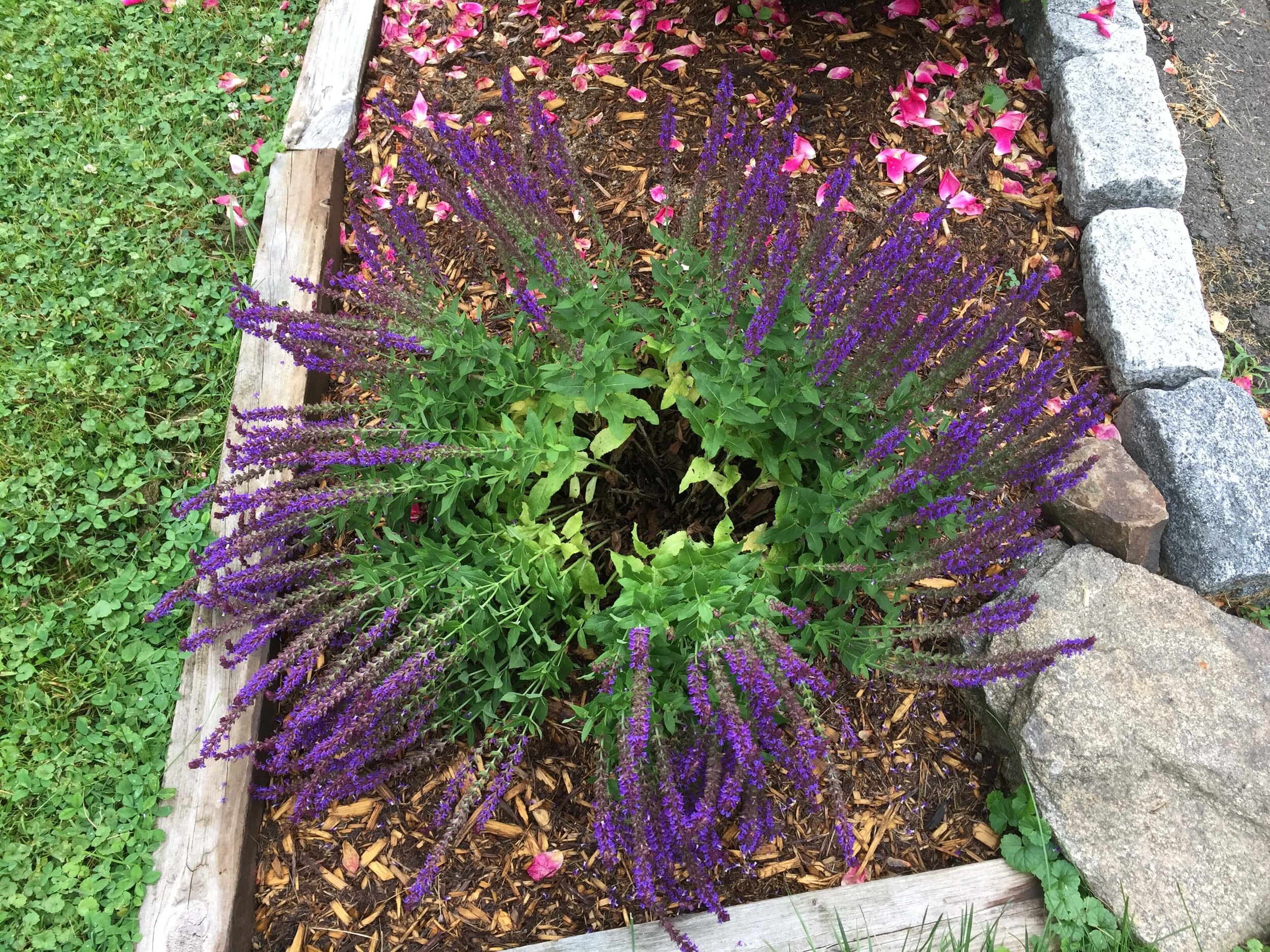To keep salvias blooming, provide them with well-draining soil, regular watering, and full sun exposure. Additionally, deadhead the flowers regularly and fertilize every 4-6 weeks with a balanced fertilizer.
Proper care and maintenance of salvias will ensure continuous blooming throughout the season, attracting pollinators to your garden. Salvias, also known as sage plants, are popular garden flowers that bring vibrant colors and attract pollinators. Their long-lasting blooms make them a favorite among gardeners.
However, to keep salvias blooming throughout the season, certain care and maintenance practices need to be followed. We will explore the key steps you can take to ensure your salvias remain in full bloom. By understanding the needs of these beautiful plants, you can create a thriving garden filled with colorful salvias that will leave a lasting impression on anyone who sets eyes on them. So, let’s dive into the essential tips for keeping salvias blooming all season long.

Credit: www.joyusgarden.com
Understanding Salvias
Salvias are vibrant and beautiful flowering plants that can be a great addition to any garden. There are different varieties of salvias, each with their unique characteristics and blossoms. Some popular ones include the Salvia splendens, Salvia officinalis, and Salvia nemorosa.
To keep salvias blooming, it is essential to provide them with proper care. They require sufficient sunlight, at least six hours a day, and well-drained soil. Watering should be done regularly, keeping the soil moist but not waterlogged. Deadheading, the removal of spent blooms, promotes continuous flowering.
Fertilizing salvias every four to six weeks during the growing season helps maintain their health and vigor. Pruning is also crucial to encourage new growth and prevent legginess. By understanding the different varieties and following these basic care requirements, you can enjoy a bountiful display of blooms from your salvias throughout the season.
Factors Affecting Blooming
Salvias thrive when exposed to the right amount of sunlight and temperature. Soil type and pH levels play a crucial role in their blooming. It is important to understand the water needs of salvias and maintain optimum moisture levels. Providing the right combination of these factors will ensure continuous blooming and healthy growth of salvias.
Light and temperature requirements should be carefully monitored to provide the ideal conditions for these flowers. Soil type and pH levels should be assessed and maintained to match the specific needs of salvias. Watering should be done regularly, with attention to the moisture levels to prevent over or under watering.
By ensuring these factors are met, you can enjoy a continuous display of vibrant salvias in your garden.
How to Keep Salvias Blooming: Step by Step Guide
Pruning Techniques
Keeping salvias blooming requires proper pruning techniques. Pruning is important as it helps stimulate new growth and maintain the shape of the plant. It is essential to prune salvias at the right time and using the correct method. By removing dead flowers and stems, you not only improve the plant’s appearance but also encourage it to produce more blooms.
Regular trimming throughout the growing season prevents the plant from becoming leggy and promotes a bushier and healthier growth. Additionally, cutting back salvias after their first blooming period helps extend their flowering season. So remember to prune your salvias effectively, and you’ll enjoy a vibrant display of blooms throughout the year.
Fertilization Tips
When it comes to keeping salvias blooming, choosing the right fertilizer is crucial. The frequency and timing of fertilization play a significant role in maintaining their vibrant blooms. It is essential to follow these guidelines to ensure the health of your salvias.
Avoid overused words and phrases and keep your sentences concise, with a maximum of 20 words each. Use a variety of expressions at the beginning of your paragraphs to engage the reader. By selecting the appropriate fertilizer and fertilizing at the right intervals, you can ensure that your salvias continue to thrive and produce beautiful blooms.
Remember to consider the specific needs of these plants and provide them with the nutrients they require, promoting continuous growth and flowering throughout the season.
Pest And Disease Management
Salvias are susceptible to various pests, which can hinder their blooming potential. Some common pests that affect salvias include aphids, spider mites, and whiteflies. To manage these pests naturally, you can introduce beneficial insects like ladybugs or lacewings, which are natural predators.
Neem oil or insecticidal soap can also be used as chemical control options. Regularly inspecting your salvias for signs of pest activity is crucial in catching and addressing the problem early. In addition to pests, salvias can also be susceptible to diseases like powdery mildew or root rot.
Ensuring proper sunlight, adequate spacing, and good air circulation around your salvias can help prevent these diseases. Regularly removing any damaged or diseased foliage can also help keep your salvias healthy and blooming throughout the season.
Overwintering Salvias
Overwintering salvias is essential to ensure they continue to bloom year after year. Protecting salvias during winter is crucial for their survival. Follow these tips for successful overwintering: 1. Provide insulation by adding a thick layer of mulch around the base of the plants.
2. Cover salvias with a frost cloth or burlap during freezing temperatures to protect them from the cold. 3. Move potted salvias to a sheltered area such as a garage or basement, where they can be shielded from harsh weather conditions.
4. Prune salvias in late fall to remove any dead or damaged parts, promoting better growth in the coming year. 5. Avoid excessive watering during winter to prevent rotting and waterlogged roots. 6. Keep an eye out for signs of pests or diseases and take proactive measures to address them promptly.
By following these guidelines, you can successfully overwinter your salvias and ensure their vibrant blooms for the next season.
Propagation Methods
Propagation methods play a crucial role in keeping salvias blooming. There are various ways to propagate these beautiful plants, and choosing the right method depends on your specific needs. It’s important to consider factors such as time, effort, and success rates.
One effective method is stem cuttings, where you snip a healthy portion of the plant and root it in a suitable growing medium. Another option is division, which involves separating a mature plant into smaller sections, each containing roots and shoots.
This method works well for salvias with multiple stems. Additionally, you can also propagate salvias through layering, by encouraging stems to root while still attached to the parent plant. Whichever method you choose, following proper care and providing suitable growing conditions will greatly enhance the chances of success.
Happy propagating!
Companion Planting
Companion planting with ideal plants is a great way to enhance the blooming of salvias. Pairing salvias with compatible companions can provide various benefits. For instance, planting them alongside marigolds can help deter pests and attract beneficial insects. The bright colors and strong scents of salvias also pair well with other vibrant flowers like zinnias or cosmos, creating an eye-catching display in your garden.
Additionally, consider pairing salvias with plants that have similar water and light requirements, ensuring they thrive together. For example, combining salvias with drought-tolerant plants like lavender or yarrow can create a low-maintenance and water-wise garden. Experimenting with different companion plants for salvias can lead to a stunning and long-lasting blooming season.
Troubleshooting Common Issues
Salvias can be temperamental plants, so it’s important to troubleshoot any issues that arise. One common problem is nutrient deficiencies, which can lead to excessive or insufficient blooming. To identify nutrient deficiencies, look for signs like yellowing leaves, stunted growth, or weak flowering.
If you notice these symptoms, address the issue promptly by fertilizing the salvia with a balanced plant food. Choose a fertilizer with equal parts nitrogen, phosphorus, and potassium to provide the necessary nutrients. Additionally, ensure that the salvia is receiving adequate sunlight and water, as these factors can also affect blooming.
By monitoring nutrient levels and making adjustments as needed, you can keep your salvias blooming beautifully throughout the season. So, next time you notice any blooming issues with your salvias, consider nutrient deficiencies as a potential culprit and take the appropriate steps to remedy the situation.
Frequently Asked Questions (Faqs)
Salvias thrive with regular watering, especially during hot and dry spells. Container gardening is a great option for salvias, allowing for easy mobility and control of soil conditions. These plants do best in full sun, as they require ample light to flourish and produce vibrant blooms.
Providing them with at least six hours of direct sunlight each day will ensure optimal growth. Remember to water your salvias deeply, allowing the soil to dry out slightly before the next watering session. Overwatering can lead to root rot and other issues, so it’s essential to strike a balance.
By following these guidelines, you can keep your salvias blooming and enjoy their beauty throughout the season.
Frequently Asked Questions On How To Keep Salvias Blooming
Are You Supposed To Deadhead Salvias?
Yes, deadheading salvias is recommended for promoting new growth and prolonged blooming.
When Should Salvias Be Cut Back?
Salvias should be cut back in the late winter or early spring for best results.
Should I Cut Back Salvias After Flowering?
Yes, cutting back salvias after flowering is recommended for their overall health and to encourage more blooms.
Is Miracle Grow Good For Salvias?
Miracle Grow is beneficial for salvias due to its nutrient-rich formula, promoting healthy growth.
Conclusion
Salvias are a beautiful addition to any garden, but keeping them blooming can be a challenge. By following these tips and tricks, you can ensure that your salvias continue to thrive and produce vibrant blooms throughout the growing season. Firstly, remember to provide them with the right amount of sun and water, as salvias are sun-loving plants and need regular watering.
Secondly, deadheading faded flowers will encourage more blooms and prolong the flowering period. Thirdly, regularly fertilize your salvias with a balanced fertilizer to provide essential nutrients for healthy growth. Additionally, pruning your salvias in early spring will help promote bushier growth and more flowers.
Lastly, be aware of common pests and diseases that can affect salvias, and take necessary preventive measures. By implementing these strategies, you can enjoy a stunning and long-lasting display of salvias in your garden. Happy gardening!

